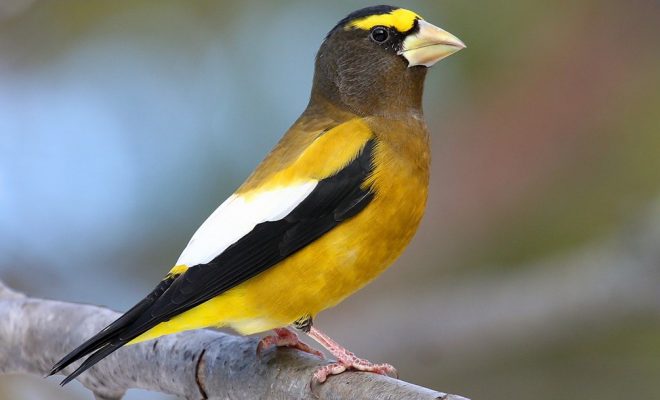Evening Grosbeaks can be attracted with black oil sunflower seeds presented on a platform feeder.
Photo taken by Ryan Brady.
The pandemic may be dictating that this is the winter for the state’s birders to play it safe, but that doesn’t mean we can’t still enjoy one of our favorite pastimes.
Yes, most birders are staying at home, or close to home, in their birding activities, especially with the spike in Covid-19 cases and more indoor living. Accordingly, the Wisconsin DNR suggests, this is a fine opportunity to watch your backyard feeders, expand your feeding station, and take short birding day-trips to take advantage of seasonal opportunities.
Evening Grosbeaks are appearing at feeders throughout Wisconsin for the first time in years. After a very poor year in 2019, the “winter finches” are defying predictions by showing in excellent diversity and numbers. First it was Purple Finches and Pine Siskins, then came both White-winged and Red Crossbills, and now it’s Common Redpolls and Evening Grosbeaks. A Hoary Redpoll was being seen in Door County.
Northern birders are also finding Pine Grosbeaks and, to a lesser extent, Bohemian Waxwings, which also have shown up more recently in Manitowoc and Grant Counties.
You can attract many of these species with black oil sunflower seeds presented in a platform feeder or other flat surface along with a water source. Redpolls and siskins also enjoy nyjer (thistle), while spruces with good cone crops offer the best chance of spotting White-winged Crossbills. Weedy fields, fruiting shrubs and seeds of ash, maple and boxelder are also places to watch.
While you may be inclined to want to check out winter finches and associated birds at local feeding stations, be aware that the simple act of providing fresh water for birds at yard-feeders often will attract and help sustain a great variety of birds during any season. And that goes for late-fall and winter, too.
There are two basic styles of heated winter bird baths. The easiest to use is a fully integrated bath that has a built-in heater. These baths only need to be plugged in and they will stay liquid even on the coldest days, thanks to the heating element hidden in the basin.
If you don't have this type of bath available, however, you can add an immersion heater to a regular bird bath. These separate heaters plug in and the heating element is submerged in the water, where it will keep at least a portion of the water liquid. Immersion heaters are not quite as efficient as fully heated baths, but either type is useful to provide liquid water for backyard birds.
What’s the best option for you? The one you can afford and find easily, and simply by Googling “heated bird baths near me” you will find multiple options and lots of advice.
Some basic tips:
-- Read all the instructions for your heated bird bath or external heating element before use, and follow the instructions carefully.
-- Place the heated bath in a sunny area and choose a dark-colored bath so it can absorb solar radiation and work with less electricity. A dark basin will also be more visible to birds when the ground is white.
-- Keep the basin filled appropriately, checking daily for evaporation and splashing that can drain the water. Do not operate it without water to avoid damage to the unit.
-- Clean the bird bath regularly so the water is fresh
-- Never add salt, antifreeze or other chemicals to the birdbath to keep the water from freezing. These chemicals can be fatal to the birds, even in small doses.
-- Use only outdoor extension cords to connect a heated birdbath or heating element. Adding electrical tape or several layers of plastic wrap over the connection will help prevent moisture from short-circuiting the cord.
-- Clear off the edge of the birdbath after a heavy snowfall to give birds a place to perch in reach of the water's surface. The snow can be brushed into the water to refill the basin as it melts.
Bryan Lenz, glass collisions program manager for the American Bird Conservancy, offers one important plea:
“Nearly 50% of window collisions happen at buildings under three stories tall, including homes – and the worst windows are often those across from bird feeders and bird baths. So, if you put out resources to bring birds to your yard, please treat your windows to keep them alive while they are there. Visit www.birdsmartglass.org for solutions – and check back in the coming weeks for our brand new collisions website!”
-- This is one of several timely articles in this month's Badger Birder newsletter; don't miss out on the latest birding and conservation news. Become a WSO member today! --


